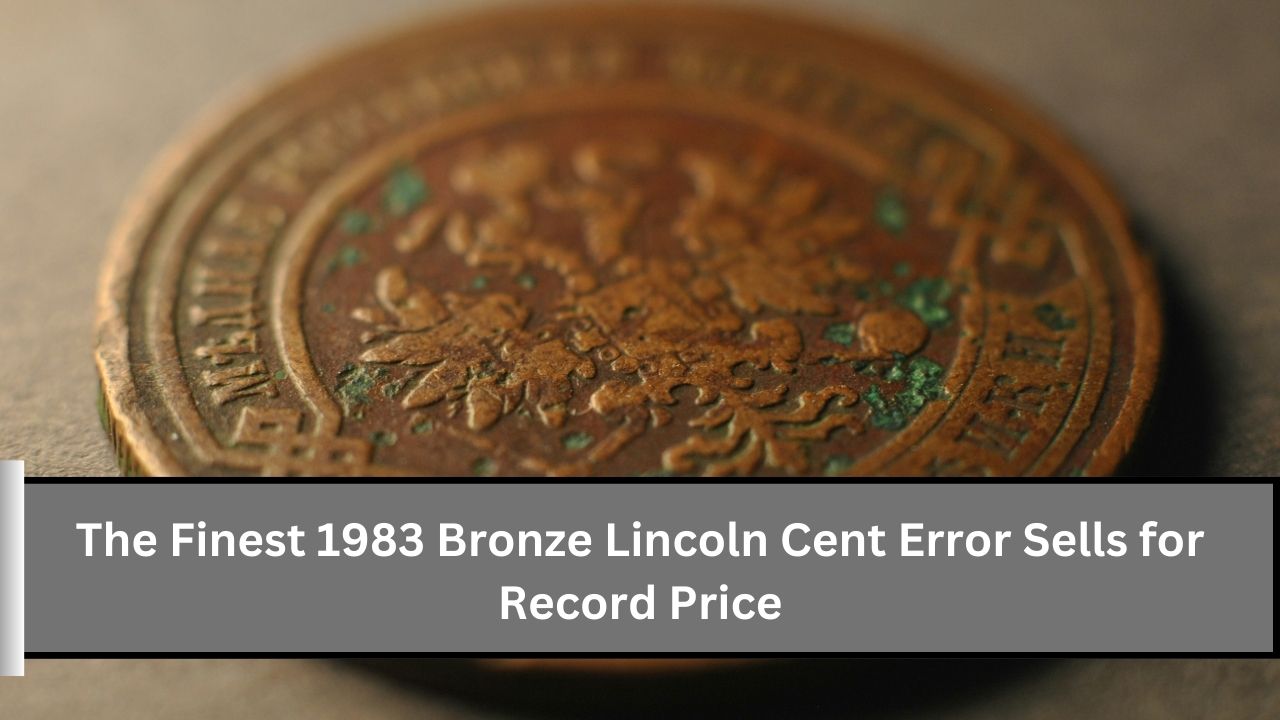Coin collecting can be an exciting hobby, especially when it comes to rare coins. Recently, a special coin called the 1983 bronze Lincoln cent made headlines by selling for a record price. This coin is not just any regular penny; it’s a unique error coin that collectors highly value. In this article, we will explore the story behind the 1983 bronze Lincoln cent error, why it’s so special, and what its record sale means for the world of coin collecting.
The Background of the 1983 Lincoln Cent
The Lincoln Cent: A Brief History
The Lincoln cent, often just called a penny, first came out in 1909 to celebrate Abraham Lincoln’s 100th birthday. Over the years, this coin has changed its design several times. One major change happened in 1959 when the back of the coin was updated to show the Lincoln Memorial.
In 1982, something important happened: the U.S. Mint changed the materials used to make the Lincoln cent. Before 1982, the penny was made of 95% copper and 5% zinc. After that, they started using mostly zinc, with only 2.5% copper. This change was made because the price of copper was going up, making it too expensive to continue using the old material. However, a few 1983 Lincoln cents were mistakenly made from the old bronze material, making them very rare.
The Transition from Bronze to Zinc
The switch from bronze to zinc didn’t happen all at once. In 1982, the U.S. Mint produced both types of cents. This means that some coins from 1983 were struck with the old bronze mixture before the change was fully made. As collectors began to notice these errors, they realized that they had a unique chance to find something special, since only a few bronze coins were made during this period.
The Discovery of the 1983 Bronze Lincoln Cent Error
Initial Findings
In 1983, the U.S. Mint created over 7 billion Lincoln cents, most of which were made from the new zinc material. However, a small number of coins were still made from the old bronze material, which confused many collectors and mint officials. As these error coins started appearing, collectors quickly recognized their rarity and began to search for them.
Today, it is believed that fewer than ten of these 1983 bronze Lincoln cents are still in circulation. The existence of these coins is a rare and exciting find for collectors.
The Coin’s Journey
The journey of the finest 1983 bronze Lincoln cent error began when a collector found it while searching through rolls of coins. Many collectors spend hours looking through coins for valuable finds. When this individual discovered the 1983 bronze penny, it was graded by a service called the Professional Coin Grading Service (PCGS). The coin received a high grade, which increased its value.
The Sale of the 1983 Bronze Lincoln Cent
The Auction Event
Recently, the finest 1983 bronze Lincoln cent error was sold at an auction, drawing a lot of attention from collectors and investors. The auction house that handled the sale specializes in rare coins and had high hopes for this piece. As news of the auction spread, many collectors became eager to bid on it.
Record-Breaking Price
The auction ended with the coin selling for a jaw-dropping $2.52 million, breaking the record for the highest price ever paid for a Lincoln cent. This sale not only shows how much rare coins can be worth but also highlights the growing interest in coin collecting as a hobby and investment.
Factors Contributing to the High Price
Several key factors helped drive up the price of the 1983 bronze Lincoln cent error:
- Rarity: Since only a few of these coins are known to exist, their scarcity greatly increases their value.
- Historical Significance: The coin’s unique background, with its transition from bronze to zinc during a significant time in U.S. history, makes it appealing to collectors.
- Condition and Grading: The coin was graded as MS-67 Red by PCGS, which means it is in excellent condition with very few signs of wear. High-grade coins are always more desirable.
- Collector Demand: More collectors are interested in rare coins, leading to higher competition and prices in the market.
The Importance of Grading in Numismatics
Understanding Coin Grading
Coin grading is an important part of the coin collecting world. It helps people understand a coin’s quality, condition, and value. Grading systems like the one used by PCGS classify coins based on how they look, how well they are preserved, and any flaws they might have.
For the 1983 bronze Lincoln cent, being graded as MS-67 Red means it looks almost perfect, with a bright red color and no noticeable wear. This high quality makes the coin much more valuable and sought after.
How Grading Affects Market Value
The value of coins can change significantly based on their grading. Higher-graded coins can sell for much more than lower-graded ones. For example, a lower-graded 1983 bronze Lincoln cent might be worth a few thousand dollars, while a coin graded as MS-67 Red can easily be worth millions.
The Impact of the Sale on the Coin Collecting Community
Increased Interest in Rare Coins
The record sale of the 1983 bronze Lincoln cent error has sparked a renewed interest in rare coins among collectors. As news of this impressive sale spreads, many people are now searching through their own coin collections, hoping to find similar rare coins that could be valuable.
Educational Opportunities
Significant sales like this one also provide great learning opportunities for new collectors. They encourage people to learn more about coin grading, coin history, and what makes coins valuable. More collectors are joining forums, attending coin shows, and connecting online to share their knowledge and experiences.
Market Trends
The high prices for rare coins, like the one seen with the 1983 bronze Lincoln cent, might lead to a larger trend in the coin market. Collectors and investors may become even more interested in seeking out high-value coins, which could create a lively market for unique pieces. This trend might also drive up demand and prices across many types of coins.
Conclusion
The sale of the finest 1983 bronze Lincoln cent error for a record-breaking $2.52 million shows just how exciting the world of coin collecting can be. This coin’s rarity, historical importance, and excellent condition make it a fascinating piece for collectors. As the community of coin enthusiasts continues to grow, stories like this inspire both experienced collectors and newcomers to learn more about the history of coins and the potential rewards of collecting them.
Whether you are a serious collector or just curious about coins, the tale of the 1983 bronze Lincoln cent error highlights the magic of discovering rare and valuable pieces of history. As we see how much collectors are willing to pay for unique coins, it is clear that the world of numismatics will keep capturing the imaginations of many for years to come.
FAQs
1. What is the 1983 bronze Lincoln cent error?
The 1983 bronze Lincoln cent error refers to a rare mistake made during coin production when a small number of Lincoln cents were mistakenly struck using bronze instead of the new zinc composition. This error makes these coins extremely rare and valuable among collectors.
2. Why is the 1983 bronze Lincoln cent so valuable?
The 1983 bronze Lincoln cent is valuable due to its rarity, historical significance, and the high grade it received from professional grading services. Only a handful of these coins are known to exist, and they represent a unique transition in U.S. coinage from bronze to zinc.
3. How much did the finest 1983 bronze Lincoln cent sell for?
The finest 1983 bronze Lincoln cent sold for a record-breaking $2.52 million at auction, setting a new price record for Lincoln cents and highlighting the growing interest in rare coins among collectors.
4. What does coin grading mean, and why is it important?
Coin grading is a standardized method used to assess a coin’s quality, condition, and market value. It impacts how much collectors are willing to pay. Higher-graded coins, like the 1983 bronze Lincoln cent graded as MS-67 Red, are typically much more valuable than lower-graded coins.
5. How does the sale of rare coins affect the coin collecting community?
Significant sales, like that of the 1983 bronze Lincoln cent, can spark renewed interest in coin collecting. They encourage both new and experienced collectors to explore their own collections, learn more about numismatics, and participate in the market for unique and valuable coins.

